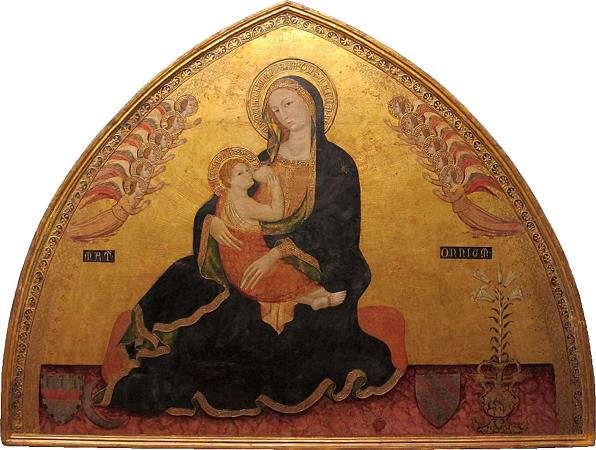Roberto d'Oderisio (c1335 - c1385). Roberto de Odorisio was an Italian painter, one of the greatest exponents of Neapolitan painting of the fourteenth century. Little biographical information is available on this Neapolitan painter. Recent studies have convincingly placed Roberto's artistic activity in the second half of the 14th century, thus excluding a direct relationship with the presence of Giotto in Naples. The cultural education of the painter, who was nevertheless influenced by the paintings executed in Naples by Giotto and especially by Maso di Banco, does not appear to be free from an accurate knowledge of Sienese painting. The first part of his activity around the middle of the century could have taken place in the Salerno area, as is attested by the works that critics have gathered around the Crucifixion preserved in the Diocesan Museum of Salerno which is his only signed work. After 1364 he executed Biblical Stories and the famous series of the Sacraments and the Triumph of the Church frescoed in the church of Santa Maria Incoronata in Naples where other cultural accents prevail, derived in part from some characteristics of the art of Simone Martini : in the context of the relationships between the Neapolitan artistic environment and the forms of international Gothic, these frescoes are one of the most valid results and best characterised by genuine narrative force. Other works attributed to him by art critics could belong to his students or other contemporary painters. In particular the beautiful diptych with Madonna and Christ in Sorrow and Saint John and the Magdalene is still of controversial attribution. From a recently re-examined and interpreted document - a deed contained in the Codex Diplomaticus Cajetanus, the Tatta property parchment, Carta DXV Bis, 1368, it emerges that Master Roberto da Napoli was commissioned to decorate the frescoes of the tribune and counter-tribune of the church of Sant'Angelo in Itri, commissioned by the first bishops and the queen of Naples Giovanna I. Master Roberto da Napoli was supposed to have been a workshop manager and worked in the churches of the fiefs of the County of Fondi, in the service of the Caetani of Anagni. Through the study of the historical-artistic context and in the iconographic stylistic comparisons, it is noted that the stylistic features of Oderisio's painting of the Crucifixion of Eboli are repeated in the fourteenth-century fresco with the Crucifixion of the upper register placed on the counter-façade of the Collegiate Church of San Michele Arcangelo of Itri and in the churches of the fiefdom of Traetto, or in the fourteenth-century frescoes of the Cathedral of San Pietro Apostolo, of the church of San Francesco and in the church of the Annunziata. Roberto di Odorisio is finally documented on 1 February 1382, when King Charles III of Durazzo appointed him as his familiar guest in the palace and first court painter with a salary of thirty ounces per year. He probably died in the 1380s.
more...






